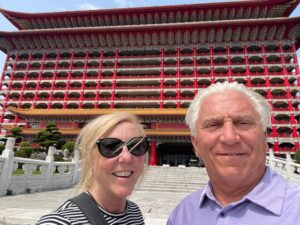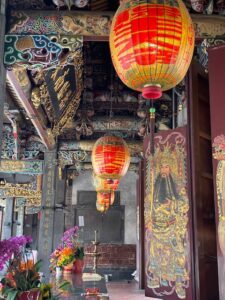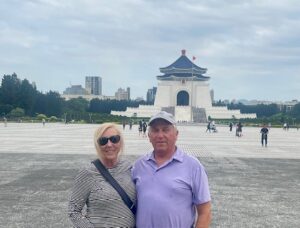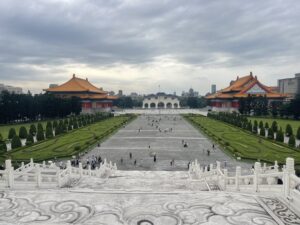
Keelung is officially know as Keelung City, it is a provincial city of Taiwan Province, Republic of China. It is in the northeastern part of the island. Nicknamed the Rainy Port for its frequent rain and maritime role, the city is Taiwan’s second largest seaport (after Kaoshsiung) only 45 minutes from Taipei City. We are docked here for two days and we look forward to discovering the port area. But first…our Taipei excursion…Day 1.
Our excursion today was aptly named Taipei’s highlights. We took a relaxing drive from Keelung City into Taipei. It was Monday morning and the highway was busy. Here in Taiwan, like much of the world, there is a five day work week. Our guide had a map of Taiwan posted on the bus entrance and shared that Taiwan is 244 miles long and divided by five mountain ranges between coasts. Consequently, all major highways run vertically. It has 400 years of history. It was initially called Formosa (by locals) as it means “beautiful island.” In 1624 the Dutch settled in Taiwan and eventually it was under Chinese rule, Japanese rule and then Chiang Kai-Shek began as President in 1949 and they gained their independence. This remains under contention from China but our guide was careful not to talk about the politics surrounding that contention. 2 million people live in Taipei city and it is a busy metropolis.
Our tour started with a visit to Dalongdong Baoan temple. The present temple was built by those clans that immigrated to Taipei in the early 19th century and gave it the name Pao-An Temple, a magnificent place of worship dedicated to Pashen Tati, the god of medicine. Built in 1830 and restored to its original glory from 1995 to 2002 after years of neglect as a bamboo factory and Japanese language school, this splendid temple impresses with ornate dragon pillars, stone lions and valuable tablets inscribed by eminent Chinese scholars. This magnificent temple, boasting superb architecture, is the foremost of about 30 Confucian temples in Taiwan.
The Taipei Confucius Temple is across the street and equally as beautiful. This temple is modeled after the original Confucius Temple in Qufu, Shandong. This is Taipei’s only one adorned with southern Fujian-style ceramic adornments. At the main hall one can see a black plaque with gold lettering which was inscribed by Chiang Kai-shek that reads “Educate without Discrimination.”
After leaving the temples, we arrived to the National Palace Museum, where we took in the largest collection of ancient Chinese objects and art in the world. Spanning more than 8,000 years, the impressive collections included bronze, paintings, jade, ceramics, and precious objects amassed by ancient emperors and more from the Sung, Yuan, Ming and Qing dynasties. There is a permanent collection of nearly 700,00 pieces of artifacts and artworks. Our guide shared with us that many of the artifacts were moved from the Palace Museum in the Forbidden City as well as five other institutions in mainland China during the ROA retreat (in 1925) and eventually returned to Taiwan and placed in the current museum by grants from The Rockefeller Foundation in 1965. Many of the artifacts are from the Ming Dynasty 1368-1644. Our guide pointed out a Docai tea cup that is one of a set that was originally 21 but 6 are housed here in the museum. One of the 21 cups was purchased by a private collector for a price of $36 million USD.
Our next stop was the Grand Hotel for a delicious Asian-style lunch. The palatial Grand Hotel was built in 1952 in the decadent style of classical Chinese architecture. Ronald Regan and Dwight D. Eisenhower both stayed here. We enjoyed lunch and walked around the grounds prior to reboarding our bus for our next stop.
The National Revolutionary Martyrs’ Shrine was a treat as we were able to watch the changing of the guard done at 2:00 pm. On the slopes of the Quig Mountain, it is a stately monument constructed in 1969 to honor the 330,000 brave men who sacrificed their lives in key battles. With a style reminiscent of Beijing’s Taihe Dian Imperial Palace, this stunning shrine is surrounded by more than eight acres of grass and features a bright red main gate guarded by uniformed officers.
Our last stop was The Chiang Kai-Shek Memorial Hall – a regal monument paying tribute to the former President of Taiwan. With its brilliant blue glazed-tile roof, gold apex, white marble and natural red cypress ceiling, the shrine is designed to convey sacredness, solemnity, hospitality and peace. Inside, were valuable artifacts related to the late president’s life, including photographs, cars and historic documents. The hall was surrounded by beautiful gardens and Koi ponds that we walked through on our way back to our tour bus.














Congratulations on the halfway mark. Very Cool. Enjoy the next 40 days.